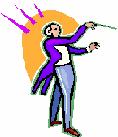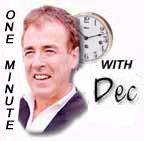![]() | Choose from List of Articles? | Next Article?
| Choose from List of Articles? | Next Article?![]()

|
|
||||||||||
|
|||||||||||
|
|||||||||||
|
|||||||||||
|
|||||||||||
“String Section recording with a synth?
HOW?" String writing and string recording can be a dark mystery...just how is it done?

Strings can sound awesome and really add to an arrangement or just make it sound downright amateur....how do the 'pros' do it?
Read on....
Strings
The most important thing in playing any sample, and particularly strings is to play 'the section', in other words, play as if you are in the room with the violins, violas, cellos, contrabass making the sound. Ask yourself the questions:
Is the studio huge [The old Number 3 at Decca, where Mantovani recorded his hundreds of Hit Records, was like a hanger...I was there last week]
Is it a cosy little studio with six fiddles squeezed in and the engineer using every trick of Hit Recording to make them sound like twenty?
How many strings are there in the room?
How many different sections? Violins? Violas? Cellos? Arco Contrabass [bowed double bass]
Once you have got the general idea in your brain [it will be different for each track] then you have to PLAN how you are going to do it.
For instance, I love a bouncy dance track where there is a chill out section in the middle and suddenly a huge mellow string orchestra plays for eight bars...did it last night ...what an effect...but takes a lot of planning and a lot of playing.
A dance track or a modern day POP track may just have a single line of violins...or at most, violins and violas playing in octaves...this is usually because the producer/programmer/arranger hasn't a clue about proper strings...so, you have to be aware that sometimes YOU have to think that way...I have to force myself sometime to be simplistic and not clutter up the frequencies...maybe that is why your strings 'take over', do they?
Understanding the different styles
Also, in this style of string arranging you have to be desperately careful that the strings are in a frequency where they will be 'heard'...and that is not a lot to do with volume; it is strictly to do with the frequency range..in other words where they are playing ...are they in the vocal frequency? guitar frequency? piano frequency? You really have to examine the writing of the strings and make sure they are playing in a frequency where no one else is playing...this way they will be heard.
Next, you have to make sure they are only playing when they should! In other words, again, they should only play in 'the cracks' between the vocal lines...a huge mistake which amateur arrangers make is to have everything playing at once..then they wonder why the track is stodgy and you can't hear a defined vocal...so beware!...Sibelius: "music is the silence between the notes".
Check out DJ Dean: 'The Launch'...I have Members of my 'Serious Writers Guild'
quiz me about a synth sound that is that size....the reason why it is that size is that there is nothing else playing! Simple!Also remember that the lower and longer the string notes, the stodgier the track will become...that is why most dance tracks use sparse, very high strings....Donna Summer started that trend and it is still valid today. So to bounce? Make 'em short, high and sparse.
If you use a full section of strings then you have to have the TOON to take it...say a Robbie Williams track or a Radiohead or in the extreme a Michael Watson track.
With my 'Bachelors' stuff I do this a lot...makes it all sound very 'expensive'...particularly when you add harp/harp glisses/belltree...this definitely adds gloss and indefinable 'quality'.
The Big String Sound
For a huge section you have to think and plan.....you MUST use a touch sensitive keyboard. And NEVER use the compression/limiting facility on the computer...it brings all notes to the same level...kills the natural feel...again, be careful of compression and limiting when mixing strings...let them make it exciting not flatten out the emotion.
Timbrality/Polyphony
You will be limited by the polyphony of the various modules...and also by the 'sound' of the modules.
Don't even think about the 'big sound' if you only use one sound module or keyboard....you will be deeply disappointed! It all boils down to the theory [which no one can fathom out] that when all your sound comes out of just left/right on a module, then the resulting sound is tiny in the extreme..it's as if all those sounds are fighting to get out of just two small holes.
Most guys like me prefer the tried and tested modules for 'real sounds', like strings, trumpets etc. The modern day synth based string sounds etc. are just fake sounding. Probably the best string sounds will be from the ancient Roland U110...an industry standard for all real sounds...I use two. That gives me 32 polyphony out of each.... The original AKAI sound library strings are edgy and have lots of resin [bow noise]. Very realistic. There are many great string samples available from reputable sample dealers...I use 'Natural Strings' from Metra Sound ....German, I believe...a lot of good sample stuff from Germany.
So you see, already I have three different lots of 'real' strings.
I now picture the orchestra in my 'imaginary' studio as we discussed above...the leader will be sitting immediately in front of the conductor...so I will use a 'solo' violin sample just for him....if you listen to a string orchestra carefully enough, you will pick out the 'timbre' of the leader's violin within the 1st violin section...in the Sixties, a leader called Charlie Katz was on hundreds of hit records...you could pick out his slow vibrato on any record. So, I get that solo violin from a plug-in card in my U110.

A Major Trick:
This is a pro programming trick....I always make a copy of each string line on the computer..then I merge the two...that gives me two images of each violin line...they won't phase [don't know why...any other instrument would].....but watch when they play in unison with another line...they can jump in 'loudness'...again don't know why...but you will have to go back over the writing and check for jumps in loudness.. this will always be due to that problem....it's worth checking.
Now here is the next major trick:
I will pan that whole 1st and 2nd section to full left round to about two 'clock on the right pan pot....then, I will turn on one of the other modules [usually my Akai S2000...very user-unfriendly bit of kit but massively powerful]....I ascribe the same midi to that module and pan the opposite to the first module so that there is a slight overlap in the middle.
It is essential, before we go any further, to understand that you MUST have a dedicated reverb unit with stunning accurate predelay that you can 'time' to the BPM of the track....divide the BPM into 60 [secs] that will give you the fraction of a second per beat...then add two zeros and you get the milliseconds...then, use that figure or quarters or halves to get the required effect....you will IMMEDIATELY notice the difference in 'jump'.
So, a dedicated reverb unit for each module....Zoom units are excellent for this purpose ...very clean and very accurate....and extremely reasonably priced.
So, two modules and two reverb units with the predelays aligned. String reverbs have to be very long...typically 4 secs [yes, four seconds]
Now the violas.....first choose a separate midi number....
Much misunderstood and NEVER written properly...it would take a book to explain the logic of viola writing...I have studied it in depth with great success...the violas add the 'class' to the string section.
You must get a dedicated viola sample. Then you must study the writing of Viola lines...generally 1st and 2nd and playing extremely closely together half note, one note two notes apart...sounds weird on it's own but in the total section sounds wonderful.
I will have another dedicated module for the violas...and use one of the violin reverb units [or the two] for this.
Cellos next
Choose a different midi number yet again...and a proper cello sample.... OK, I have the luxury of other samplers...but they are not expensive when bought 'properly'.

Cellos only play unison, fifths, octaves or tenths...they NEVER play close harmony...it just muddies the waters. Causes hours of grief when mixing, trying to figure out where the 'rolling' is coming from [that rolling, rumbling sound is always either acoustic guitar or cellos] By playing open harmony [fifths etc.] then the human ear fills in all the missing harmonics...so a section might play
Contrabass: octave down C
Cellos: next octave C, G, E root, fifth and tenth
Violas: next octave D, E close together
Violins two desks high C, E [or they can play two notes each...nice effect!]
You will see in there a lot of empty space...but the sound will be huge.
SAMPLES:
A logic which is much misunderstood.....amateurs will always try to change the sound of a sample...forgetting that a dedicated research and development guy spent six months of hard work getting that sample to sound PERFECT. I know - I've been that amateur frigging about with Simmons cymbals for hours only to arrive back where I started.
ALWAYS BELIEVE THE SAMPLE.
Get yourself the 'Abbey Road Studios' reference CD so you can actually check what a sample of your proposed sound is 'expected' to sound like...excellent tool. [Available from Studiospares]
Samples rarely need EQ unless to adjust the frequency fractionally for 'space within a track'.
So - if the violin sounds wrong...it is wrong...change the sample!....and bin the dud one!
"The 'Monster' man, the greatest agent in the world - Eric Hall, at the Dusty Springfield memorial tribute with Dec and Sandy - then the man himself with Dec!"
A final note:
Just as a classy lady can put an expensive 'correct' accessory with an inexpensive top when she dresses to impress, so you can put a cheap sounding sample with an expensive production....likewise, you can put an expensive sounding string section with a grungy production [Radiohead? Travis?]
And always remember the power in using that expensive sounding section for just 8 or 16 bars...stunning!
Of course, the string orchestra sounds at it's best on it's own....now that is sheer class...takes a lot of guts...but my Goodness, does it work?
THE BEST TIP:
A classy trick, used since music was invented, is to have a 'live' instrument...voices, el. guitar maybe, or French Horn, play in unison with the lead violin...now there is a sound!
Typical Question from Members of my 'Serious Writers Guild': "From your experience what is the most common mistake we are likely to make initially?"
The biggest mistake is just extracting from my writings what you want to hear...and preferring to not listen to the 'whole story'....the 'whole story' works...only using the parts which suit you will only improve the parts you want improved and not the WHOLE.
As regards being successful and famous and most of all RICH? Most common mistakes are: not improving looks, image...and MOST PARTICULARLY accent and overall demeanor...which is the most important bit in music.
As regards recording and music?
Not listening to and dissecting the charts each week and striving to create better than the Top Three.
As regards equipment?
Believing the adverts and straying from 'Industry Standard'. Being sucked down the PC VST route...strictly amateur!
Not using enough modules [I use 10 minimum, in a mix] and not using enough effects units [I would use 13 in my current mixes]...and mostly, not understanding the necessity to use as many compressors as you can lay your hands on.
But mostly not following everything I suggest to the letter....
You just have to DO IT!
And always remember :
"The Music is the Easy Bit"
Quickly - on the subject of 'string lines'.
Good string writing tends to be the same as good accapella writing...the arrangement stands up on it's own without accompaniment and is an entity unto itself.
A common mistake is to have ALL the strings playing at the same time....we only do that on rare occasions and usually when each 'section' has made a statement and all play the end of an 8 bar or 16 bar phrase.
Listen to the great arrangers [the Nat King Cole string arrangements are treated as 'text book' arrangements]
Amateurs just play handfuls of chords and feel this is string arranging...not a bit. And NEVER play the dreaded 'string pad'...it has no part in proper POP arranging. Typically, the two first desks would make an entry, followed by the violas a couple of bars later, in a contrapuntal sense, and then the cellos .... Wurlitzer organ players took a lot of their technique from string arrangements.
So, let each section 'speak' for itself and then, like an army, when you need power for the assault, let all the sections join together.
AND ALWAYS BE AWARE THAT THE MOST POWERFUL SOUND IN A STRING ORCHESTRA IS UNISON/OCTAVES.
Listen to the last note of any major classical piece...what do you hear? UNISON.
Lecture over...
I invite some of the more serious Members of my 'Serious Writers Guild' to have 3 days in my studio......only Members...so don't even ask!
Revision [March 2005]
This page is one of the most popular on the 'Makehits' sites. So it generates a lot of questions:
For instance:
"I read your web page about synth string arrangements.... Just one thing I wanted to confirm that I'm not to sure about. When you say record the 1st section of violins (six desks = twelve violins) do you mean twelve different violin sounds? Or do u mean use the same sound and record it twelve times? Does that also apply to the cello, viola, contrabass.....?Many thanks DecElliot (Serious Writers Guild Member)"
I replied:

Regards
DEC [Cluskey]
dec@makehits.co.uk
|
Become a Member of the 'The Serious Writers Guild'
CLICK HERE When you get involved with DEC you get the first program: "How To Make A $Million From your Music" - ten months of two knowledge packed books a month, songwriting tips, stunning advice, today's methods for writing music, making music and promoting it. 24/7 access to the man himself. And you get a 'LIFETIME' guarantee. If you ever pay DEC for anything, if you are not happy at anytime in your life with the product then return it for a complete, no-quibble, courteous refund! DEC means it!
That's not only a guarantee it's a personal promise
"There Is No Catch"
"There Is No Risk"
Become a Member of the 'The Serious Writers Guild' CLICK HERE |

 |
Dec's advice : Get in touch personally. Email dec@makehits.com to discuss what you want to achieve in music. |